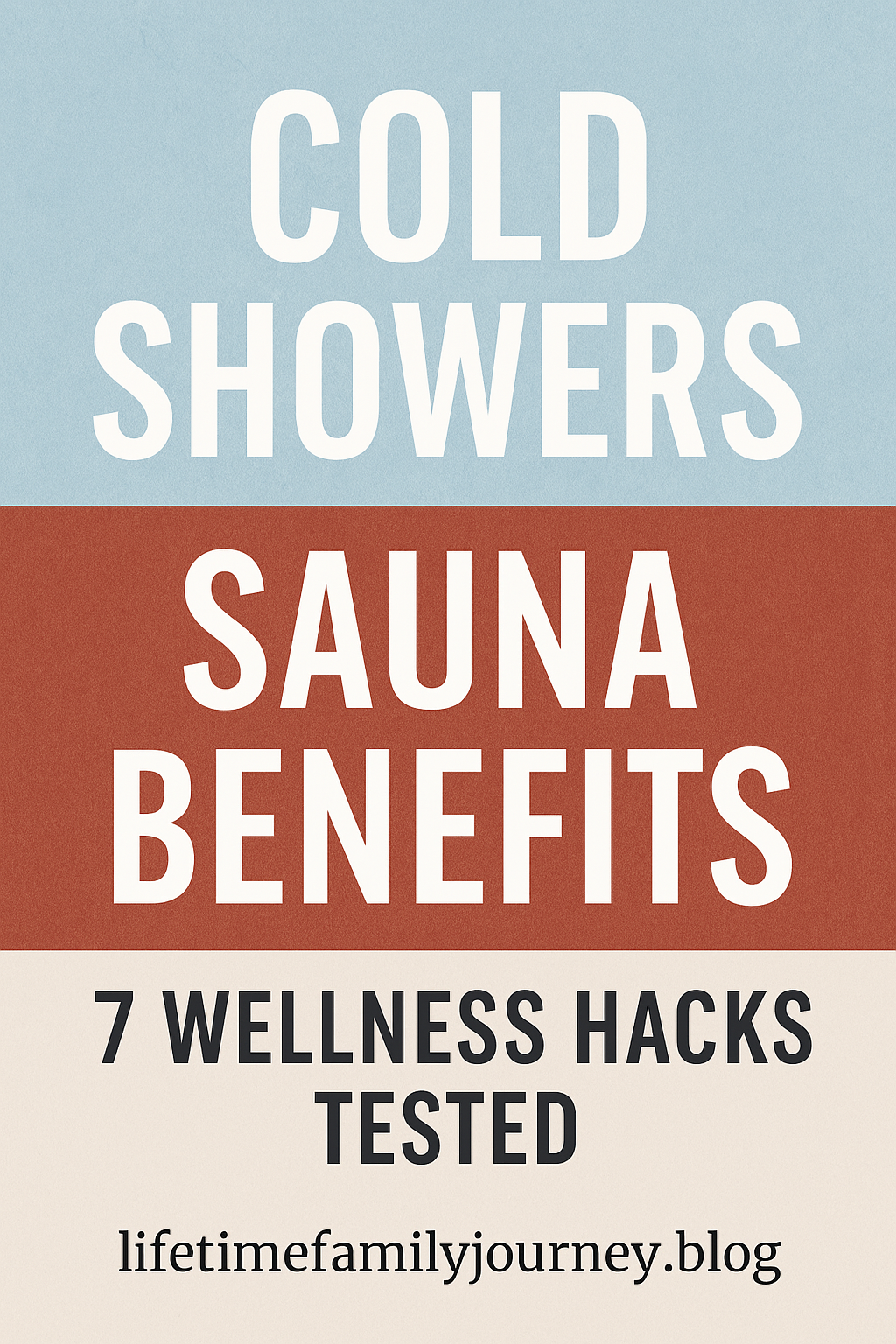Cold Showers and Sauna Benefits: 7 Wellness Hacks Tested
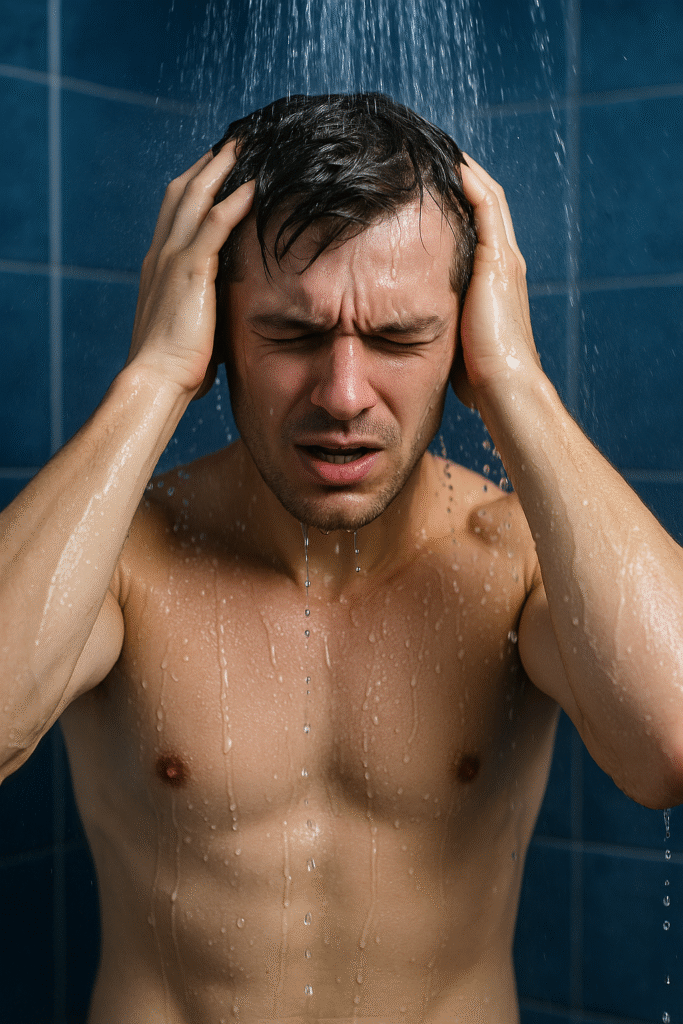
Picture me, dad of six, standing under freezing water at 6 AM questioning my life choices while my kids pound on the bathroom door asking where their Pokemon cards are. 🚿❄️ This is modern parenting meets wellness culture—a bizarre intersection where ice baths are trendy and everyone’s an expert on optimizing their circadian rhythm.
We live in an era where influencers swear by cold plunges that cost more than my minivan 💰, infrared saunas that require their own zip code 🏠, and breathing techniques that supposedly unlock superhuman potential 🧘♂️. Meanwhile, I’m over here wondering if these wellness hacks actually work or if they’re just expensive ways to make regular people feel inadequate about their shower temperature preferences.
As someone who’s tried everything from Wim Hof breathing (spoiler: I hyperventilated 😵💫) to contrast therapy in my backyard (the neighbors still haven’t recovered 👀), I’ve learned that most wellness trends fall into two categories: genuinely helpful practices that can fit into real life, and flashy fads that work better as Instagram content than actual lifestyle changes.
This isn’t another post promising you’ll become a superhuman biohacker by week three. Instead, it’s a dad-tested, science-backed look at cold showers and sauna benefits that you can actually implement without reorganizing your entire existence around optimal temperature exposure.
Why We Chase Wellness Hacks in the First Place
Let’s be honest about why busy parents get sucked into wellness trends. We’re desperately seeking shortcuts because nobody has two hours daily for yoga, cryotherapy sessions, and preparing kale smoothies that taste like punishment.
I watch these biohacker influencers with their perfectly curated morning routines—twenty minutes of meditation 🧘♂️, ice bath sessions 🧊, infrared sauna time 🔥, breathwork practice 🌬️, and cold-pressed vegetable juices 🥤—and I think, “Do these people have children?” My morning routine involves finding matching socks for six kids while simultaneously making coffee strong enough to resurrect the dead ☕💀.
The appeal of wellness hacks lies in their promise of maximum benefit with minimal time investment. Cold showers take two minutes. Sauna sessions can be squeezed into thirty-minute windows. These practices promise better energy, improved recovery, and enhanced mental clarity—things every parent desperately needs.
But here’s where science becomes crucial. The wellness industry thrives on testimonials and before-and-after photos, but what does actual research say about these practices? Are we chasing legitimate health benefits or just expensive ways to feel like we’re doing something productive?
The truth lies somewhere in the middle. Some wellness hacks have solid scientific backing, while others exist primarily in the realm of placebo effects and wishful thinking. The key is separating evidence-based practices from marketing-driven trends.
Just like I discussed in my positive mindset habits post, sustainable wellness isn’t about perfection—it’s about finding practices that actually work for real families with real schedules and real chaos.
Cold Showers and Sauna Benefits: The Science Behind Temperature Therapy
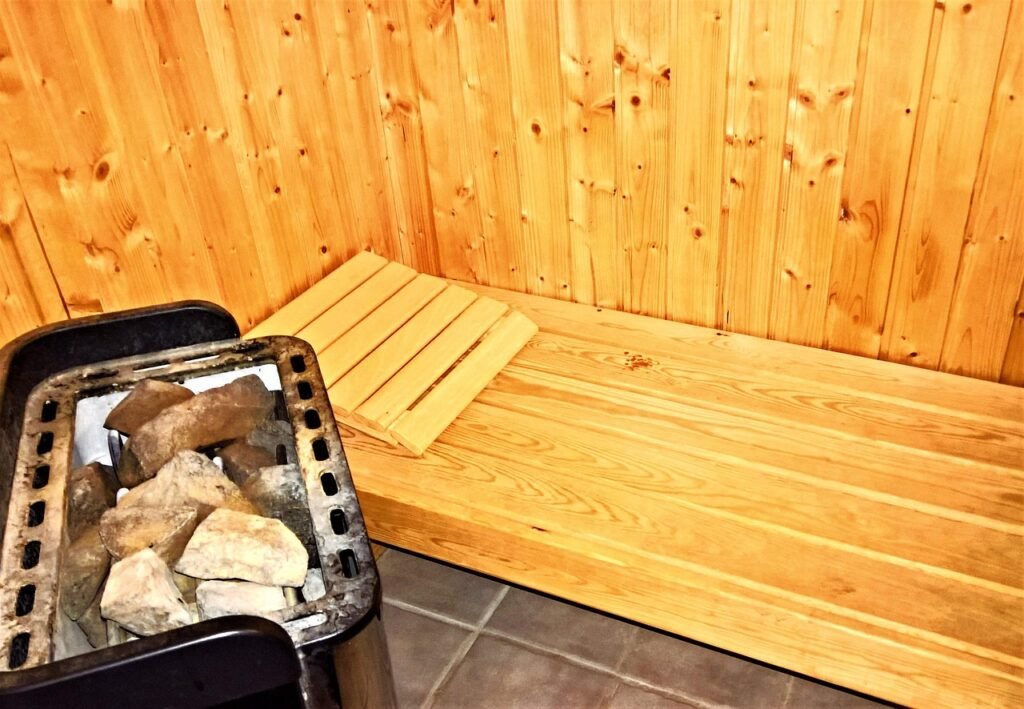
Cold shower therapy claims to boost mood, improve circulation, increase metabolism, and enhance mental resilience. According to proponents, ending your shower with 30-90 seconds of cold water can transform your day and potentially your entire life.
The supposed mechanisms include activation of the sympathetic nervous system, increased noradrenaline production, improved brown fat activation, and enhanced immune response. Sounds impressive, right?
My real experience started with genuine dread every morning. That moment when you reach for the faucet handle, knowing what’s coming, feels like preparing for voluntary torture. The initial shock hits like a full-body slap, causing an involuntary gasp that probably woke half the neighborhood.
But something interesting happened after the first week 🤔. The anticipatory anxiety decreased, and I noticed a distinct mental clarity following each cold exposure. Not the life-changing euphoria some people describe, but a genuine sense of alertness that coffee couldn’t replicate ⚡.
Research suggests cold exposure does trigger several physiological responses. A study published in Medical Hypotheses found that cold showers might help alleviate depression symptoms by activating the sympathetic nervous system and increasing beta-endorphin levels. Another study in the European Journal of Applied Physiology showed improved cold tolerance and potential metabolic benefits.
The practical approach that actually works: Start your shower at normal temperature, complete your regular routine, then gradually decrease the temperature for the final 30-60 seconds. Don’t aim for arctic conditions immediately—moderately cool water still provides cold showers and sauna benefits while being sustainable long-term.
Important safety considerations: ⚠️ People with heart conditions, high blood pressure, or certain medical conditions should consult healthcare providers before starting cold exposure therapy. Pregnant women should also avoid extreme temperature changes. For families with young children, cold showers aren’t appropriate for kids under 12, whose thermoregulation systems are still developing.
The mental aspect proved most interesting. Cold exposure requires present-moment awareness—you can’t zone out or multitask when freezing water hits your skin. This forced mindfulness creates a natural meditation practice that’s particularly valuable for busy parents who struggle finding dedicated quiet time.
Sauna Sessions: Heat Therapy That Actually Works
Traditional sauna culture promises detoxification, stress relief, cardiovascular benefits, and improved recovery. The market offers dry saunas, steam rooms, and infrared saunas, each claiming unique advantages for achieving optimal cold showers and sauna benefits.
Traditional dry saunas operate at 150-195°F with low humidity, creating intense heat that promotes sweating and cardiovascular responses similar to moderate exercise. Steam rooms maintain lower temperatures (100-110°F) with nearly 100% humidity. Infrared saunas use light to heat the body directly rather than heating the surrounding air.

My first sauna experience felt like being slowly roasted alive 🔥😅. Sitting in 180-degree heat while trying to practice mindful breathing resulted in what I can only describe as “aggressive relaxation.” The claimed detoxification benefits through sweating sound appealing, but research shows minimal toxin elimination through sweat compared to liver and kidney function.
However, legitimate cardiovascular benefits exist ❤️. Studies published in JAMA Internal Medicine found regular sauna use associated with reduced risk of cardiovascular disease and all-cause mortality. The heat stress appears to provide conditioning effects similar to moderate physical exercise.
The stress relief aspect proved genuinely effective 😌. Twenty minutes in a sauna forces you to disconnect from devices and external distractions. This digital detox combined with heat-induced relaxation creates legitimate stress reduction—something busy parents desperately need 🙏.
For family wellness, teenagers can generally use saunas safely with proper supervision and shorter sessions (10-15 minutes maximum). Younger children should avoid sauna use entirely, as their bodies struggle to regulate temperature effectively. Pregnant women should also avoid saunas due to overheating risks.
The key is avoiding the “more is better” mentality. Sessions longer than 20-30 minutes or temperatures exceeding personal comfort zones don’t provide additional benefits and may cause dehydration or heat exhaustion.
Practical home alternatives include steam showers or portable infrared units, though nothing replaces the full sauna experience. The social aspect of communal saunas also provides community connection that’s difficult to replicate at home—similar to how family fishing adventures create bonding opportunities through shared experiences.
Contrast Therapy: The Nordic Secret to Recovery
Nordic countries have practiced contrast therapy for centuries—alternating between sauna heat and cold water plunges. This hot-cold cycling supposedly reduces inflammation, improves circulation, and enhances recovery, maximizing cold showers and sauna benefits through temperature variation.
The theoretical mechanism involves vasodilation during heat exposure followed by vasoconstriction during cold exposure, creating a “vascular pump” effect that may improve circulation and reduce inflammatory markers.
My backyard experiment involved hot shower sessions followed by cold hose exposure in winter. The neighbors definitely questioned my sanity, but the experience provided insights into this practice’s legitimate benefits and obvious limitations.
Research on contrast therapy shows mixed but promising results 📊. A study by Plos One found contrast water therapy helped reduce muscle soreness after intense exercise. Another study in Scientific Reports showed improved recovery markers in athletes using alternating hot-cold exposure.
The inflammation connection involves heat shock proteins activated during heat exposure and cold shock proteins triggered during cold exposure. These proteins may help cellular repair and reduce inflammatory responses, though research is still emerging.
Practical implementation at home proved challenging but not impossible. Hot baths followed by cold showers provide similar effects without requiring specialized equipment. The key is maintaining consistent temperature differences and timing—typically 3-4 minutes hot followed by 1-2 minutes cold, repeated 2-3 cycles.

Family participation requires careful consideration. Adults and older teenagers can practice modified contrast therapy safely, but extreme temperatures remain inappropriate for younger children. Starting with mild temperature variations helps build tolerance gradually.
The recovery benefits seemed most apparent after intense workouts or particularly stressful days. While not miraculous, contrast therapy did appear to reduce muscle soreness and improve subjective energy levels the following day.
Breathwork and Advanced Wellness Practices
Breathing techniques, particularly the Wim Hof Method, claim to improve stress resilience, boost immune function, and enhance mental clarity through controlled hyperventilation followed by breath retention—another approach to maximizing cold showers and sauna benefits through physiological manipulation.
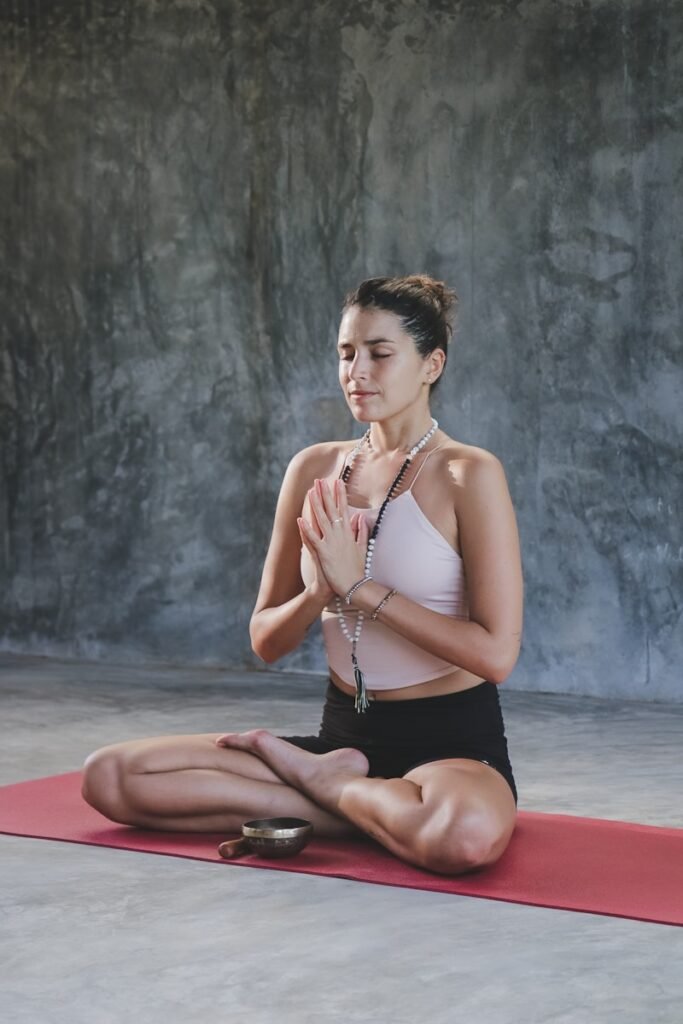
The Wim Hof Method involves 30 deep breaths followed by breath retention, repeated in cycles. Proponents claim this practice allows conscious control over autonomic nervous system responses typically considered involuntary.
My attempt at Wim Hof breathing resulted in tingling sensations, light-headedness, and what I can only describe as feeling slightly high 🤪. While interesting, the hyperventilation aspect raised concerns about safety, particularly for people with certain medical conditions.
Research on controlled breathing techniques shows legitimate physiological effects. Studies demonstrate that specific breathing patterns can influence heart rate variability, stress hormone levels, and inflammatory markers. However, extreme breathing techniques may not be appropriate for everyone.
More accessible breathing practices include simple diaphragmatic breathing, box breathing (4-4-4-4 pattern), or the 4-7-8 technique popularized by Dr. Andrew Weil. These approaches provide stress reduction benefits without the intensity of more extreme methods.
Other wellness hacks I tested with varying degrees of success include:
Grounding or “earthing” involves direct skin contact with the earth’s surface. While research is limited, spending time barefoot outdoors does provide stress relief and connection with nature. My neighbors found my barefoot yard sessions amusing, but the practice genuinely felt grounding (pun intended) 🌱.
Red light therapy claims to improve cellular energy production and reduce inflammation. Home devices are expensive and research remains preliminary, making this a lower priority for busy parents compared to proven cold showers and sauna benefits.
Meditation apps provide guided practices that fit into busy schedules. Even five-minute sessions can provide stress relief and improved focus, making this one of the most practical wellness hacks for parents. As I mentioned in my 50 uplifting words post, small daily practices can create significant positive changes over time.
The key is choosing practices that align with your lifestyle and stress levels rather than trying to implement every trending technique simultaneously.
The Science Behind Inflammation and Recovery
Understanding how cold and heat exposure affect the body helps separate legitimate benefits from marketing hype. Both temperature extremes trigger stress responses that may provide adaptive benefits when applied appropriately, contributing to documented cold showers and sauna benefits.
Cold exposure activates the sympathetic nervous system, releasing noradrenaline and triggering various physiological responses. These include vasoconstriction, increased heart rate, and activation of brown adipose tissue for thermogenesis. Regular cold exposure may improve cold tolerance and potentially influence metabolic markers.
Research published in PLoS One found that people practicing cold water swimming showed improved antioxidant protection and decreased oxidative stress.

Heat exposure triggers heat shock protein production, which may help cellular repair and stress resilience 💪. Sauna use also provides cardiovascular conditioning effects through increased heart rate and improved circulation.
The inflammation connection involves multiple pathways. Cold exposure may reduce pro-inflammatory cytokines while heat exposure can trigger anti-inflammatory responses through heat shock proteins. However, the inflammation-recovery relationship is complex, and extreme temperature exposure isn’t appropriate for everyone.
Legitimate applications include:
- Athletic recovery: Both heat and cold therapy show benefits for reducing exercise-induced muscle damage and improving recovery times 🏃♂️
- Chronic pain management: Some studies suggest temperature therapy may help certain pain conditions, though individual responses vary significantly
- Stress management: Both practices provide stress relief through forced present-moment awareness and physiological relaxation responses 🧘♀️
- Cardiovascular conditioning: Regular sauna use appears to provide legitimate cardiovascular benefits for healthy individuals ❤️
Important limitations include individual variation in responses, potential risks for certain medical conditions, and the need for gradual adaptation rather than extreme exposure.
Just as I emphasized in my fitness industry needs change article, the most effective approaches prioritize sustainable practices over extreme measures that most people can’t maintain long-term.
Family Wellness Hacks That Actually Work
After testing numerous wellness trends, the most effective family health practices are surprisingly simple and require minimal equipment or time investment while still providing legitimate cold showers and sauna benefits where appropriate.
Evening family walks provide multiple benefits: physical activity, stress reduction, family bonding time, and natural light exposure that supports healthy circadian rhythms 🌅. These walks cost nothing, require no special equipment, and scale easily with family size and ages.
Hydration before caffeine creates a simple energy hack that works 💧. Drinking 16-20 ounces of water upon waking helps combat dehydration-induced fatigue and may reduce caffeine dependence over time. Kids can participate by establishing their own morning hydration routines.
Family stretch or yoga sessions transform screen time into active time 🧘♀️. YouTube offers countless family-friendly yoga videos, and the inevitable giggling and imperfect poses create bonding experiences while improving flexibility and stress relief.
Digital sunset routines involve powering down devices 1-2 hours before bedtime 📱. This practice improves sleep quality for the entire family and creates space for reading, conversation, or other relaxing activities. Similar to the principles I discussed regarding responsible pet ownership, consistency and commitment are key to success.
Gratitude sharing during dinner or bedtime provides mental health benefits backed by research 🙏. Each family member shares one thing they appreciated about their day, creating positive focus and family connection.
Kitchen dance parties while preparing dinner combine physical activity with family fun 💃🕺. Five minutes of dancing burns calories, relieves stress, and creates positive associations with healthy food preparation.
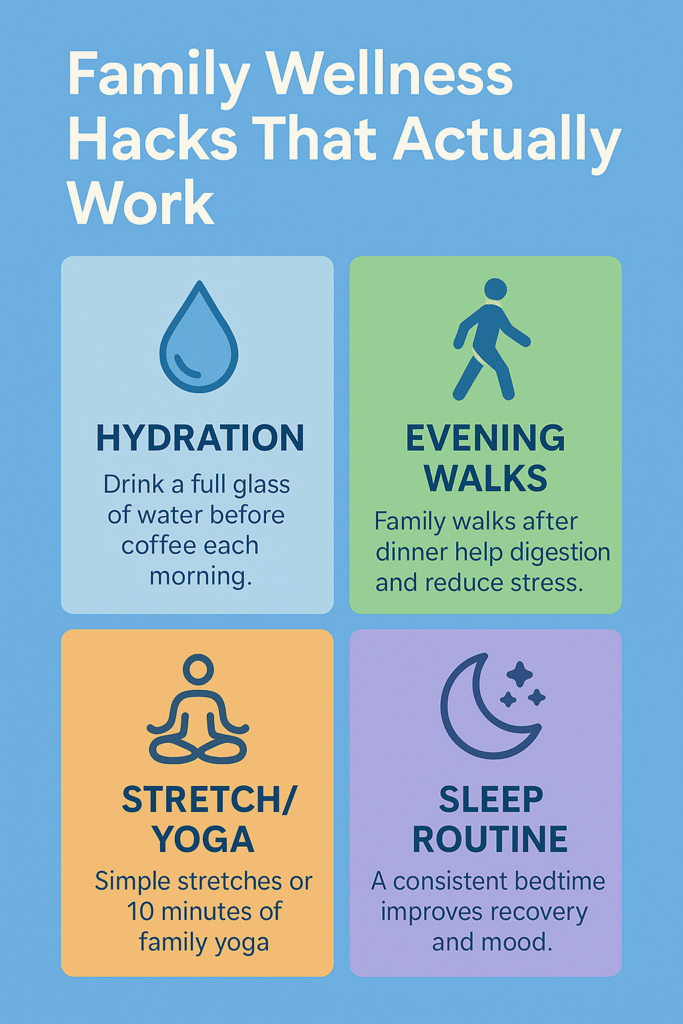
The sustainability factor makes these practices superior to more extreme wellness trends. They require minimal time and resources while providing genuine benefits for the entire family. Most importantly, they’re enjoyable enough that kids actually want to participate rather than viewing them as parental health obsessions.
Connection to broader wellness principles includes recognizing that the most effective health practices are those you can maintain consistently over time. Extreme temperature exposure or complex breathing techniques may provide benefits, but simple practices integrated into daily routines often produce better long-term results.
Wellness Hacks for Different Life Stages
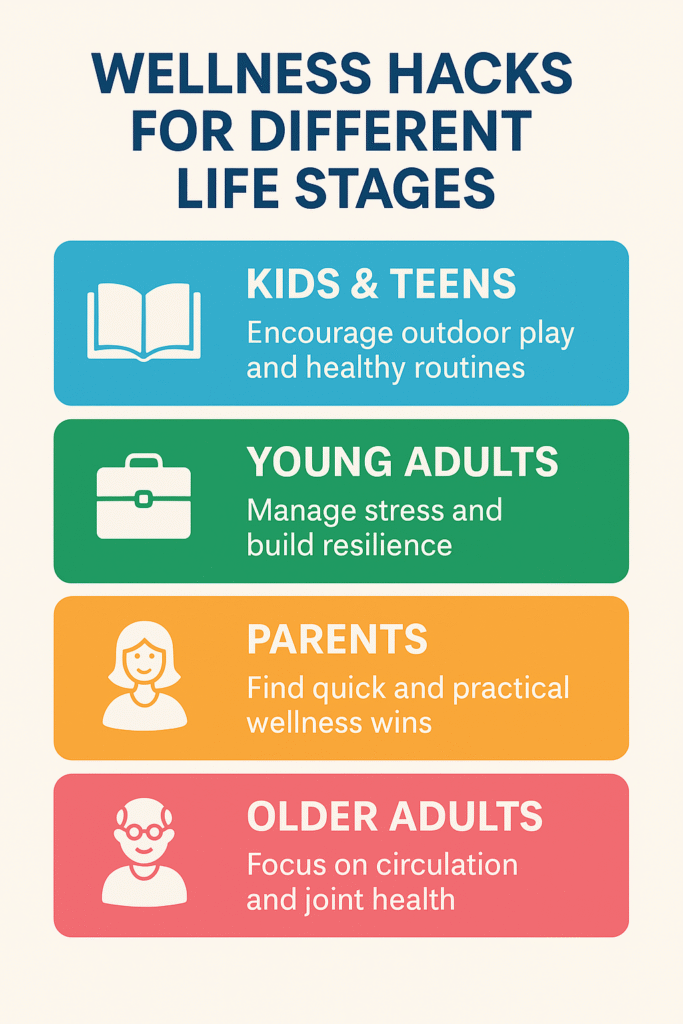
Understanding that wellness needs change throughout family life helps optimize which practices to prioritize. Cold showers and sauna benefits may appeal differently to various family members based on age, health status, and lifestyle demands.
For busy parents (my demographic), the focus should be on time-efficient practices that provide maximum stress relief and energy benefits. Cold showers fit perfectly into existing routines, while sauna sessions can serve as brief escapes from constant family demands.
For teenagers, temperature therapy can become part of athletic recovery routines or stress management during academic pressures. However, education about proper techniques and safety precautions is essential. The social aspects of sauna culture can also provide positive peer interactions around wellness rather than less healthy activities.
For younger children, direct participation in extreme temperature therapy isn’t appropriate, but they can learn about the principles through age-appropriate activities like contrast foot baths (warm to cool water) or family discussions about stress management techniques.
For grandparents or older family members, gentler applications of temperature therapy may provide joint pain relief and circulation benefits, though medical consultation is particularly important for this demographic due to increased health risks.
The key insight from testing these approaches across different scenarios is that flexibility and adaptation matter more than rigid adherence to specific protocols. A single parent might benefit from quick cold showers for energy, while someone dealing with chronic pain might find more value in gentle heat therapy.
Creating Your Personalized Wellness Protocol
Rather than attempting to implement every wellness hack simultaneously, successful integration requires a systematic approach that builds sustainable habits over time while incorporating proven cold showers and sauna benefits where appropriate for your situation.
Week 1-2: Assessment Phase 📋 Start by honestly evaluating your current energy levels, stress patterns, and available time. Most parents overestimate their available bandwidth for new practices. Begin with one simple change, such as ending showers with 30 seconds of cooler water or taking a five-minute walk after dinner.
Week 3-4: Foundation Building 🏗️ Once the first practice becomes routine, add a second element. This might involve extending cold water exposure or incorporating basic breathing exercises during stressful moments. The goal is consistency rather than intensity.
Week 5-8: Integration and Expansion 📈 With two practices established, consider adding heat therapy if accessible, or enhancing existing practices. This phase focuses on making wellness habits feel natural rather than forced additions to your routine.
Beyond Two Months: Optimization and Maintenance ⚖️ Long-term success involves periodic assessment of what’s working and what isn’t. Some practices may become permanent fixtures while others might be seasonal or situational tools.
Personal experience suggests that trying to revolutionize everything at once leads to abandoning everything within weeks. The parents who successfully maintain wellness practices are those who start small, build gradually, and prioritize practices that genuinely improve their daily experience.
Similar to the approach I discussed in my home cleaning tips guide, systematic implementation beats sporadic intensive efforts every time.

Making Wellness Work for Real Life
The wellness industry often promotes all-or-nothing approaches that don’t align with real family life. The most effective strategy involves selecting evidence-based practices that fit your schedule, budget, and family dynamics while understanding the genuine cold showers and sauna benefits available to you.
Cold showers may not transform you into a superhuman biohacker, but they do provide a quick mental reset that works better than six kids arguing about cereal. Sauna sessions offer legitimate stress relief and cardiovascular benefits, even if you feel more like a rotisserie chicken than a zen master 🐔.
Key insights from testing these wellness hacks include:
Start small and build gradually rather than attempting dramatic lifestyle overhauls. Thirty seconds of cold water is more sustainable than five-minute ice baths. Fifteen-minute sauna sessions provide benefits without overwhelming busy schedules.
Focus on practices with multiple benefits. Family walks improve fitness, reduce stress, and create bonding opportunities simultaneously. Evening gratitude sharing enhances mental health while strengthening family relationships.
Prioritize consistency over intensity. Regular moderate practices provide better long-term benefits than sporadic extreme efforts. Sustainable wellness habits integrate naturally into existing routines rather than requiring complete schedule reorganization.
Consider individual family member needs and preferences. What works for parents may not be appropriate or appealing for children. Finding practices everyone can participate in creates family wellness culture rather than individual health obsessions.
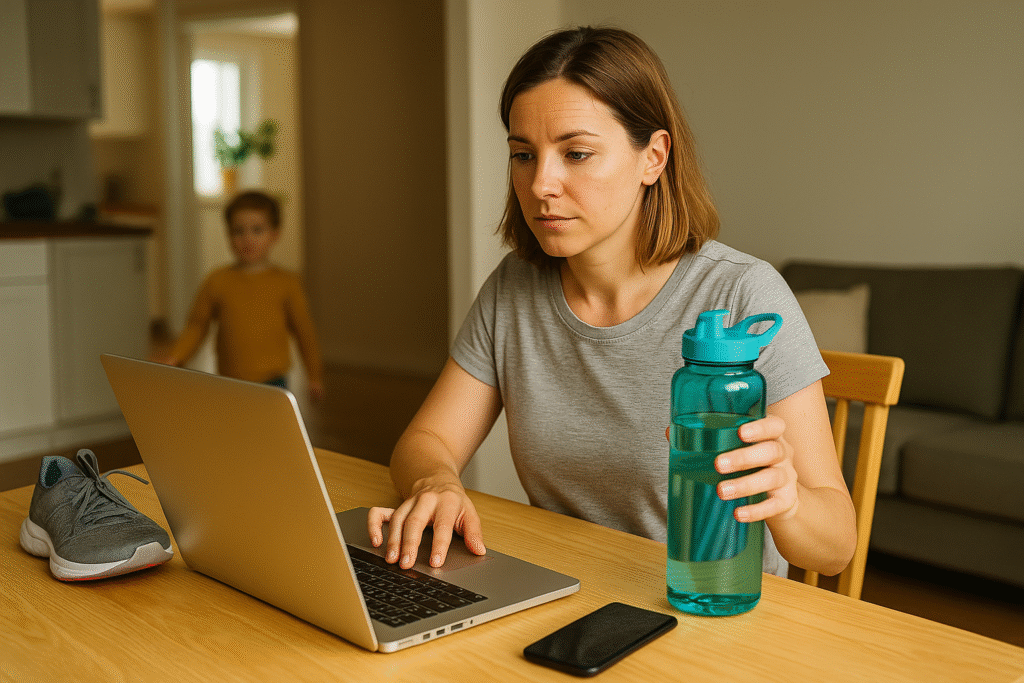
Budget considerations matter 💰. The most expensive wellness equipment doesn’t necessarily provide superior benefits compared to free or low-cost alternatives. Cold showers cost nothing additional beyond your water bill. Family walks require only comfortable shoes.
Scientific backing should guide practice selection. While testimonials and social media success stories are inspiring, research-supported practices provide more reliable benefits. Stick to wellness hacks with legitimate scientific foundation rather than trendy but unproven techniques.
The Reality Check: What Works vs. What’s Hype
After months of testing various wellness practices, the honest truth is that most benefits come from consistency with simple, evidence-based approaches rather than extreme measures or expensive equipment.
Practices with solid evidence and real-world sustainability: ✅
- Brief cold water exposure at shower’s end
- Regular sauna sessions (if accessible)
- Basic breathing exercises during stress
- Family physical activities
- Consistent sleep routines
- Hydration before caffeine
Practices that sound impressive but proved impractical for most families: ❌
- Extended ice baths requiring special equipment
- Complex breathing protocols requiring significant time
- Expensive home infrared saunas
- Complicated supplement regimens
- Extreme dietary restrictions
- Multi-hour morning routines
The most valuable discovery was that wellness isn’t about optimization—it’s about finding practices that genuinely make you feel better while being sustainable enough to maintain during life’s inevitable chaos.
When my teenager has a meltdown, the washing machine floods the basement, and dinner burns simultaneously, elaborate wellness protocols become irrelevant. What matters are simple tools that provide quick stress relief and energy boosts without adding complexity to already overwhelming days.
This aligns with insights from my back to school ready parent guide—the most effective strategies are those that work during high-stress periods, not just during calm, controlled circumstances.

Your Next Step Forward
If you’re ready to test some of these wellness hacks, start with one practice this week rather than attempting to revolutionize your entire routine. Choose something that appeals to you and fits your current lifestyle constraints while considering proven cold showers and sauna benefits that align with your goals.
For busy parents, I recommend starting with: 👥
- Adding 30 seconds of cool water to your existing shower routine ❄️
- Instituting five-minute family walks after dinner 🚶♀️🚶♂️
- Establishing a simple gratitude sharing practice during meals 🍽️
- Trying basic breathing exercises during stressful moments 🌬️
The goal isn’t perfection or complete lifestyle transformation. It’s finding evidence-based practices that provide genuine benefits while fitting into the controlled chaos of family life.
Remember that wellness isn’t about achieving influencer-level optimization—it’s about feeling better, having more energy for your family, and managing stress more effectively 💯. Cold showers may not make you immortal, but they did wake me up faster than six kids arguing about cereal ever could 😂.
The most important wellness hack of all? 🎯 Giving yourself permission to experiment, adjust practices based on what actually works for your family, and ignore the pressure to implement every trending technique perfectly.

Your health and your family’s wellbeing deserve attention and care, but they don’t require expensive equipment, extreme measures, or complete lifestyle overhauls. Sometimes the best wellness hack is simply choosing to prioritize practices that make you feel better while being sustainable enough to maintain long-term.
Start where you are, use what you have, and do what you can. That’s the real secret to making wellness work for real life ✨.
Looking for more practical family wellness ideas? Check out our Music Tastes: 7 Spectacular Insights from a Band Geek for more thoughts on family bonding, explore our VA Disability Process Guide for veteran-specific wellness considerations, or discover strategies for maintaining wellness during busy periods in our comprehensive family guides.
More from Our Family of Blogs:
Lifetime Family Journey – Stories, guides, and lessons from life in a big family.
Mountains Will Move – Faith, resilience, and encouragement for life’s hardest battles.
Everyday Exposed – Real talk on culture, media, and the world we’re raising our kids in.
